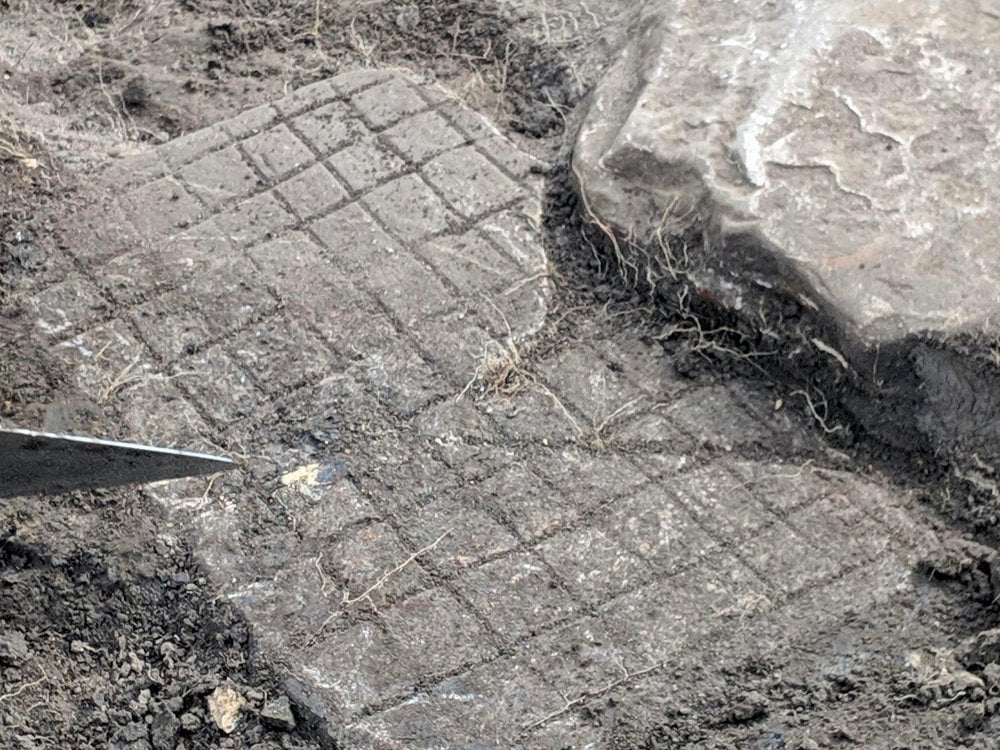Archaeologists Uncover an Ancient Roman Game Board at Hadrian’s Wall
The cracked stone board was likely used to play ludus latrunculorum, Rome’s favorite game.
Life in the Roman legions is often presented as constant excitement, with endless military campaigns subduing people throughout Europe and the Near East. But the truth is Roman soldiers had down time.

As evidenced by a gridded gaming board recently uncovered during excavations of Hadrian’s Wall, a 73-mile-long fortification in what’s now northern England that once delineated the northern frontier of the Roman Empire, soldiers played games to pass the time.
Tony Henderson at Chronicle Live reports that the cracked stone game board was uncovered late last month while archaeologists excavated a third century building behind the bath house at Vindolanda, one of 14 forts along Hadrian’s Wall. It’s believed that the board was likely used in the bath house, but was repurposed as a floor stone in the adjacent building after it was broken.
It’s unknown how the board was cracked, but a spokesperson for the site tells Henderson it could be a colorful story. “You can almost picture the losing Roman tipping the board up in frustration, causing it to break,” he says.
This is not the only game board found at Vindolanda. Five other boards dating from the third to fifth centuries have been found along with glass and stone gaming tokens.
Construction of Hadrian’s Wall began in 122 A.D. at Roman emperor Hadrian’s behest and took six years to complete. It was the northernmost border of the Roman Empire until 138 A.D., when the emperor Antoninus Pius abandoned it and built a turf wall about 100 miles to the north.
Twenty years later, the Romans had to fall back to Hadrian’s Wall due to attacks by Caledonian tribes. The forts along Hadrian’s Wall were then occupied by Roman forces until around 400 A.D.
So what were soldiers on the frontier playing to pass the time? The grid on the stone is for a game called ludus latrunculorum, translated from Latin as “the game of mercenaries.” While archaeologists have found game boards and pieces at sites all across the Roman Empire, they have yet to figure out exactly how the game is played.
The website Ancient Games reports that ludus is first mentioned in the second century B.C. by the writer Varro who noted that it was a game played on a grid. A poem by an anonymous writer from the first century A.D. provides some details, including the fact that players captured each other’s pieces, moving backward and forward on the board.
Roman poet Ovid reveals that pieces were captured by surrounding an opposing piece with two game tokens. The game appears to be a more sophisticated variation of checkers, but we can only speculate on the official rules of the game.
That hasn’t prevented some game lovers from trying to develop rules from the little we know, and there are even some commercial versions available.
The game board is not the only recent news from Vindolanda, which has been excavated by the Vindolanda Trust since 1970. In that time, researchers have found thousands of artifacts from legionaries, including rare items made of wood and leather that have survived in the area’s mucky, oxygen-free soil.
Most famously, in 1973, archaeologists dug up hundreds of well-preserved wooden writing tablets that give insight into life at the camp for the average soldier as well as information on how the garrison was administered.
The notes include requests for commanders to send their soldiers more beer, a letter from one entrepreneurial civilian brother to another about making some cash off the soldiers, a birthday invitation and a request for a promotion, among other topics.
Last year, diggers found two sets of rare hipposandals, or iron objects used on the feet of horses, that recently went on display at the site’s Roman Army Museum. It’s not known if they are temporary horseshoes or some sort of restraint. They also found a strange, child-size bronze hand, which was likely part of a cult ritual.
There will undoubtedly be more cool finds, and maybe more game boards. Vindolanda researchers have only excavated about 25 percent of the site. At the current pace, it will take 150 years to unearth the entire area.
